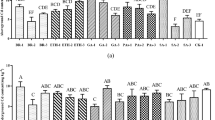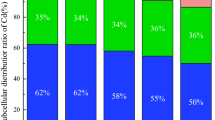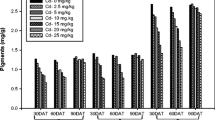Abstract
Aim
A-nine month of field trail was conducted to investigate the accumulation capacity of cadmium and zinc by Arabidopsis halleri spp. germmifera.
Methods
An experimental site moderately contaminated with Zn and Cd was chosen to evaluate the field traits of seed sowing and seedling transplantation. The exchangeable fraction and total Cd and Zn in the soil and the concentration in harvested plants were determined by inductively coupled plasma mass spectrometer.
Results
The shoot biomass of A. halleri ssp. germmifera increased after more than 8 months of cultivation, and it was approximately 2.13 t ha−1 in the seedling transplantation group, which was more than three times higher than in the seed sowing group. The lower ratio of Zn/Cd concentration in plants than in the soil and the higher bioaccumulation factor indicated that A. halleri ssp. germmifera has a higher uptake efficiency for Cd than for Zn. In total, A. halleri ssp. germmifera removed 18.20 kg Cd ha−1 and 27.38 kg Zn ha−1 from the soil. After nine months of growth, A. halleri ssp. germmifera extracted (22.87 ± 9.21) % of total Cd concentration and (2.99 ± 0.94) % of total Zn concentration from the soil. However, no significant decrease of exchangeable concentration was shown in soil Cd and Zn, which revealed that the uptake of Cd and Zn by A. halleri ssp. germmifera not only came from exchangeable forms but also from non-exchangeable fractions.
Conclusions
The results of present study indicated that A. halleri ssp. germmifera can be used to efficiently remove different forms of Cd from contaminated land.






Similar content being viewed by others
References
Assunção AGL, Bookum WM, Nelissen HJM, Vooijs R, Schat H, Ernst WHO (2003) Differential metal-specific tolerance and accumulation patterns among Thlaspi caerulescens populations originating from different soil types. New Phytol 159:411–419
Assunção AGL, Bleeker P, ten Bookum WM, Vooijs R, Schat H (2008) Intraspecific variation of metal preference patterns for hyperaccumulation in Thlaspi caerulescens: evidence from binary metal exposures. Plant Soil 303:289–299
Baker AJM, Brooks RR (1989) Terrestrial higher plants which hyperaccumulate metallic elements-a review of their distribution, ecology and phytochemistry. Biorecovery 1:81–126
Bert V, MacNair MR, DeLaguerie P, Saumitou-Laprade P, Petit D (2000) Zinc tolerance and accumulation in metallicolous and non-metallicolous populations of Arabidopsis halleri (Brassicaceae). New Phytol 146:225–233
Bert V, Meerts P, Saumitou-Laprade P, Salis P, Gruber W, Verbruggen N (2003) Genetic basis of cd tolerance and hyperaccumulation in Arabidopsis Halleri. Plant Soil 249:9–18
Blakemore LC, Searle PL, Daly BK (1987) Methods for chemical analysis of soils. New Zealand Soil Bureau Sci Rep 80:103
Bochicchio R, Sofo A, Terzano R, Gattullo CE, Amato M, Scopa A (2015) Root architecture and morphometric analysis of Arabidopsis thaliana grown in cd/cu/Zn-gradient agar dishes: a new screening technique for studying plant response to metals. Plant Physiol Biochem 91:20–27
Brewer EP, Saunders JA, Angle JS, Chaney RL, McIntosh MS (1999) Somatic hybridization between the zinc hyperacumulator Thlaspi caerulescens and Brassica napus. Theor Appl Genet 9:761–771
Chen J, Yang L, Yan X, Liu Y, Wang R, Fan T, Ren Y, Tang X, Xiao F, Liu Y, Cao S (2016) Zinc-finger transcription factor ZAT6 positively regulates cadmium tolerance through the glutathione-dependent pathway in Arabidopsis. Plant Physiol 171:707–719
Claire-Lise M, Nathalie V (2012) The use of the model species Arabidopsis halleri towards phytoextraction of cadmium polluted soils. New Biotechnol 30:9–14
Fedotov PS, Kördel W, Miró M, Peijnenburg W, Wennrich R, Huang P (2012) Extraction and fractionation methods for exposure assessment of trace metals, metalloids, and hazardous organic compounds in terrestrial environments. Crit Rev Environ Sci Technol 42:1117–1171
Fischerova Z, Tlustos P, Szakova J, Sichorova K (2005) A comparison of phytoremediation capability of selected plant species for given trace elements. Environ Pollut 144:93–100
Fonseca EM, Baptista Neto JA, Fernandez MA, Mcalister J, Smith B (2011) Geochemical behavior of heavy metals in different environments in Rodrigo de Freitas lagoon – RJ/Brazil. An Acad Bras Cienc 83:457–469
Gryschko R, Kuhnle R, Terytze K, Breuer J, Stahr K (2005) Soil extraction of readily soluble heavy metals and as with 1 M NH4NO3-solution-evaluation of DIN 19730. J Soils Sediments 5:101–106
Hammer D, Keller C (2003) Phytoextraction of cd and Zn with Thlaspi caerulescens in field traits. Soil Use Manag 19:144–149
Hammer D, Kayser A, Keller C (2003) Phytoextraction of cd and Zn with Salix viminalis in field trials. Soil Use Manag 19:187–192
Hatayama M, Sato T, Shinoda K, Inoue C (2011) Effects of cultivation conditions on the uptake of arsenit and arsenic chemical species accumulated by Pteris vittata in hydroponics. J Biosci Bioeng 111:326–332
Huguet S, Bert V, Laboudigue A, Barthes V, Isaure MP, Llorens I, Schat H, Sarret G (2012) Cd speciation and localization in the hyperaccumulator Arabidopsis halleri. J Environ Exp Bot 82:54–65
Iqbal M, Ahmad A, Ansari MKA, Qureshi MI, Aref IM, Khan PR, Hegazy SS, El-Atta H, Husen A, Hakeem K (2015) Improving the phytoextraction capacity of plants to scavenge metal(loid)-contaminated sites. Environ Rev 23:44–65
Isaure M, Huguet S, Meyer C, Castillo-Michel H, Testemale D, Vantelon D, Saumitou-Laprade P, Verbruggen N, Sarret G (2015) Evidence of various mechanisms of cd sequestration in the hyperaccumulator Arabidopsis halleri, the non-accumulator Arabidopsis lyrata, and their progenies by combined synchrotron-based techniques. J Exp Bot 66:3201–3214
Japan Meteorological Agency (2012-2013). http://www.jma.go.jp/jma/index.html
Kashem MA, Singh BR, Kondo T, Imamul Huq SM, Kawai S (2007) Comparison of extractability of cd, cu, Pb and Zn with sequential extraction in contaminated and non-contaminated soils. Int J Environ Sci Technol 4:169–176
Knight B, Zhao F, McGrath SP, Shen Z (1997) Zinc and cadmium uptake by the hyperaccumulator Thlaspi caerulescens in contaminated soils and its effects on the concentration and chemical speciation of metals in soil solution. Plant Soil 197:71–78
Krämer U (2005) Phytoremediation: novel approaches to cleaning up polluted soils. Curr Opin Biotechnol 16:133–141
Krämer U (2010) Metal hyperaccumulation in plants. Annu Rev Plant Biol 61:517–534
Kubota H, Takenaka C (2003) Arabis gemmifera is a hyperaccumulator of cd and Zn. Int J Phytorem 5:197–201
Kupper H, Lombi E, Zhao FJ, McGrath SP (2000) Cellular compartmentation of cadmium and zinc in relation to other elements in the hyperaccumulator Arabidopsis halleri. Planta 212:75–84
Li J, Liao B, Dai Z, Zhu R, Shu W (2009) Phytoextraction of cd-contaminated soil by carambola (Averrhoa carambola) in field trials. Chemosphere 76:1233–1239
McGrath SP, Shen Z, Zhao F (1997) Heavy metal uptake and chemical changes in the rhizosphere of Thlaspi caerulescens and Thlaspi ochroleucum grown in contaminated soils. Plant Soil 188:153–159
McGrath SP, Lombi E, Gray CW, Caille N, Dunham SJ, Zhao F (2006) Field evaluation of cd and Zn phytoextraction potential by the hyperaccumulators Thlaspi caerulescens and Arabidopsis halleri. Environ Pollut 141:115–125
Muehe EM, Weigold P, Adaktylou IJ, Planer-Friedrich B, Kraemer U, Kappler A, Behrens S (2015) Rhizosphere microbial community composition affects cadmium and zinc uptake by the metal-hyperaccumulating plant Arabidopsis halleri. Appl Environ Microbiol 81:2173–2181
Nair KPP (1996) The buffering power of plant nutrients and effects on availability. Adv Agron 57:237–287
Pilon-Smits E (2005) Phytoremediation. Annu Rev Plant Biol 56:15–39
Pollard AJ, Reeves RD, Baker AJ (2014) Facultative hyperaccumulation of heavy metals and metalloids. Plant Sci 217–218:8–17
Richau K, Schat H (2009) Intraspecific variation of nickel and zinc accumulation and tolerance in the hyperaccumulator Thlaspi caerulescens. Plant Soil 314:253–262
Salt DE, Smith RD, Raskin I (1998) Phytoremediation. Annu Rev Plant Biol 49:643–668
Vamerali T, Bandiera M, Mosca G (2010) Field crops for phytoremediation of metal-contaminated land. A review. Environ Chem Lett 8:1–17
Van der Ent A, Baker AJM, Reeves RD, Pollard AJ, Schat H (2013) Hyperaccumulators of metal and metalloid trace elements: facts and fiction. Plant Soil 362:319–334
Vázquez S, Moreno E, Carpena RO (2008) Bioavailability of metals and as from acidified multicontaminated soils: use of white lupin to validate several extraction methods. Environ Geochem Health 32:193–198
Veseý T, Tlustos P, Száková J (2012) Organic acid enhanced soil risk element (cd, Pb and Zn) leaching and secondary bioconcentration in water lettuce (Pistia stratiotes L.) in the rhizofiltration process. Int J Phytorem 14:335–349
Waterlot C, Pruvot C, Bidar G, Fritsch C, De Vaufleury A, Scheifler R, Douay F (2016) Prediction of extractable cd, Pb and Zn in contaminated woody habitat soils using a change point detection method. Pedosphere 26:282–298
Wenzel WW, Kirchbaumer N, Prohaska T, Stingeder G, Lombic G, Adriano DC (2001) Arsenic fractionation in soils using an improved sequential extraction procedure. Anal Chim Acta 436:309–323
Wieshammer G, Unterbrunner R, Gatcia TB, Zivkovic MF, Puschenreiter M, Wenzel WW (2007) Phytoextraction of cd and Zn from agricultural soils by Salix ssp. and intercropping of Salix caprea and Arabidopsis halleri. Plant Soil 298:255–264
Xian X, Shokohifard GI (1989) Effect of pH on chemical form and plant availability of cadmium, zinc, and lead in polluted soil. Water Air Soil Pollut 45:265–273
Zhao F, Lombi E, Breedon T, McGrath SP (2000) Zinc hyperaccumulation and cellular distribution in Arabidopsis halleri. Plant Cell Environ 23:507–514
Zhao F, Jiang R, Dunham SJ, McGrath SP (2006) Cadmium uptake, translocation and tolerance in the hyperaccumulator Arabidopsis halleri. New Phytol 172:646–654
Acknowledgements
This study was supported by Strategic Priority Research Program (B) of the Chinese Academy of Sciences (XDB15010100), National Natural Scientific Foundation of China (No. 41622104, 21501107, 41430856), Mitsui & Co., Ltd., Environment Fund (Grant No. R11-F1-011), Key Laboratory for Solid Waste Management and Environment Safety (SWMES 2013-03), Distinguished Young Scholar Program of the Jiangsu Province (BK20160050).
Author information
Authors and Affiliations
Corresponding authors
Additional information
Responsible Editor: Juan Barcelo.
Electronic supplementary material
ESM 1
Figure S1 (DOCX 371 kb)
Rights and permissions
About this article
Cite this article
Zhang, Z., Wen, X., Huang, Y. et al. Higher accumulation capacity of cadmium than zinc by Arabidopsis halleri ssp. germmifera in the field using different sowing strategies. Plant Soil 418, 165–176 (2017). https://doi.org/10.1007/s11104-017-3285-y
Received:
Accepted:
Published:
Issue Date:
DOI: https://doi.org/10.1007/s11104-017-3285-y




